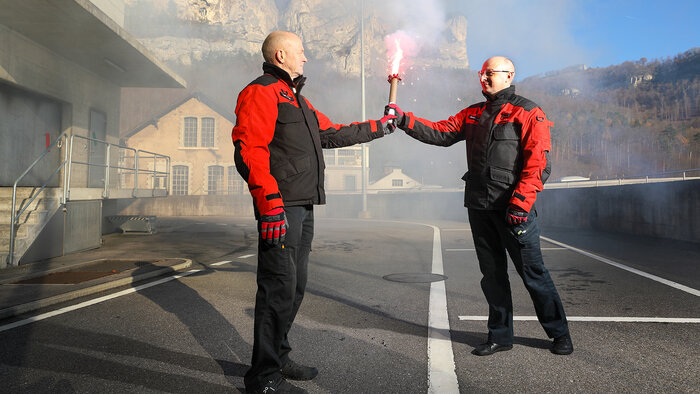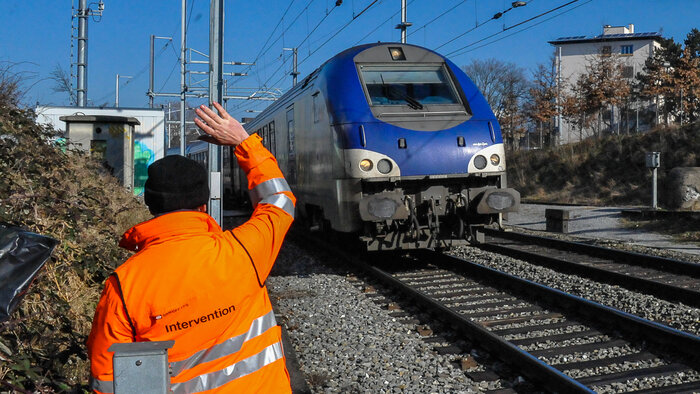Note on searching on the magazine page: Only search hits from the magazine are displayed. If the information you are looking for is not included, you can search the entire website instead by clicking on ‘Search’ in the top right-hand corner and entering the desired search term. You will then receive results from the entire website.
TunnelTrainingKnowledge
Tunnel fires from 2012 to 2023: Statistics from media reports
TunnelTrainingConsultation
Markus Vogt hands over training consulting to Clemens Pessel
TunnelTrainingKnowledge
Challenging conditions at the underground car park fire
TunnelTrainingKnowledge
Systematically reduce hazards in the event of hydrogen leaks
TunnelTrainingKnowledgeFire serviceCourses
Intensive underground car park course for firefighters
TunnelTrainingKnowledge
Digital tables for tactical tabletop simulations in the new Tactics Centre
TunnelTrainingKnowledge
Airport railway station entirely smoke-filled during train fire
TunnelTrainingKnowledge
Human behaviour during a tunnel fire (part 2/3): Motorists use all means of escape
TunnelTrainingKnowledge
Robotics in firefighting operations: technology influences tactics
TunnelTrainingKnowledge
Smoke generator for practices and trials in tunnels
TunnelTrainingFire serviceCourses
Belgian firefighters test new possibilities for underground car park operations
TunnelTrainingKnowledge
Human behaviour during a tunnel fire (part 1/3): Every tunnel user can be in need of help
TunnelTrainingKnowledge
Brief report on the 9th Fire Chief Forum: Insights and impetus
About usBackstage
Why only white smoke rises from our training tunnels
TunnelTrainingConsultationReferenceKnowledge
Seattle Fire Department tests Swiss Tunnel Firefighting Procedure
TunnelTrainingConsultationKnowledge
How we guide fire services on their way to their tunnel training
TunnelTrainingKnowledge
State Fire Service School optimises tunnel train-the-trainer courses
TunnelTrainingKnowledge
Why train drivers are grateful for a hand signal during firefighting operations
TunnelTrainingKnowledge
Hydrogen vehicles in tunnels: great danger for emergency response personnel
TunnelTrainingKnowledgeFire serviceCourses
Underground car park leaflet: tactics and techniques for firefighting operations at a glance
TunnelTrainingConsultationKnowledgeAbout usBackstageServices
Interschutz 2022: Expertise in tunnels and underground car parks in international demand
TunnelTrainingInfrastructureKnowledge
Unique rescue apparatus with special technical features
TunnelTrainingKnowledge
Fire service command structure for fire operations in tunnels: planned flexibility
TunnelTrainingKnowledge
Optimising training: What does it really take to provoke operationally relevant experiences?
TunnelTrainingKnowledge
Reversing smoke propagation - underestimated danger
TunnelTraining
How does the fire service transfer from road to rail?
TunnelTrainingKnowledge
Tunnel firefighting procedures in three languages: Textbooks for lasting training
TunnelTrainingConsultationInfrastructureReferenceAbout usBackstage
From the major fire in the Gotthard Road Tunnel in 2001 to deployment confidence in tunnel fires
TunnelTrainingKnowledge
Thuringian Fire Service School uses adventure-based education in tunnel training
TunnelTrainingKnowledge
The safety concept for the Gotthard Road Tunnel 20 years after the major fire of 2001
TunnelTrainingKnowledge
The Schadenwehr Gotthard (20 years after the major fire in October 2001)
TunnelTrainingKnowledgeFire serviceKnowledge
Towards rules of engagement for firefighting operations concerning hydrogen
TunnelTrainingConsultationKnowledge
For long rescue routes: Fire escape hoods with compressed air supply
TunnelTrainingFire serviceCourses
Didactic Concept: Teaching and Learning with Method
TunnelConsultationKnowledge
Search stick 3.0
TunnelKnowledge
Emergency exits should be manned quickly
TunnelTrainingKnowledge
Search & rescue teams stay close together in a railway tunnel
TunnelTrainingKnowledge
The operational situations in railway and road tunnels differ fundamentally
TunnelTrainingKnowledge
To carry, drag or wheel persons? A question for operational preparation
TunnelConsultationReferenceKnowledge
Include fire services in the planning of new tunnels at an early stage
TunnelTrainingConsultationReferenceKnowledge
When fire services get a tunnel - the case study of the Scheibengipfeltunnel Reutlingen
TunnelTrainingKnowledge
Ensuring learning successes: 90 seconds for motivating feedback
TunnelTrainingReference
Railway and road courses with FSCS Quality Label
TunnelTrainingReferenceKnowledge
Fire incident report of a lorry fire with dangerous goods in the Tauern road tunnel
TunnelTrainingReferenceKnowledge
Reconnaissance is always needed – but not always reconnaissance teams
TunnelTrainingReference
Fire service of a pumped hydroelectric energy storage train in a training tunnel facility
TunnelTrainingKnowledge
Leaflets support the preparation for tunnel firefighting operations
TunnelTrainingKnowledge
Deployments involving hydrogen-powered vehicles: findings from the virtual workshop
TunnelTrainingReferenceKnowledge
Fire incident report Bürgerwald Tunnel: Retaining people in vehicles?
TunnelTrainingReferenceKnowledge
Always towards the fire
TunnelTrainingReference
An easy introduction to the challenging topic of tunnels
About usBackstage
Uniform training for successful cooperation
TunnelTrainingConsultationKnowledge
Personnel requirements for tunnel operations
TunnelTrainingKnowledge
What to do when hydrogen vehicles burn?
TunnelKnowledge
Tunnel fire statistic
Fire serviceInfrastructureCourses
A big show in the Firehouse Q
TunnelConsultation
Search sticks: Feeling around instead of squatting
TunnelConsultationKnowledge
Outlook on the textbook “Firefighting Operations in Railway Tunnels”
Fire serviceInfrastructureModulesReference
The RBIFS uses the infrastructure in Balsthal
TunnelTrainingConsultationInfrastructure
Tactics Centre: Space for collective learning processes
TunnelKnowledge
The Didactics and Development Team (DDT)
Fire serviceInfrastructureCoursesReference
A SCBA module for advanced
About usBackstage










![[Translate to English:] Copyright Philipp Puliafito [Translate to English:] Copyright Philipp Puliafito](/fileadmin/_processed_/1/e/csm_ifa_MAG_779_Nussbaumen1_fd9694139c.jpg)



































![[Translate to English:] Stabsraum [Translate to English:] Stabsraum für den Lötschberg-Basistunnel mit Besprechungstisch und Funktionswesten über den Stuhllehnen](/fileadmin/_processed_/9/4/csm_ifa_MAG_418_Pilot67_2ec5b6b7d9.jpg)


![[Translate to English:] Tunnelrettungs-Komposition der Matterhorn Gotthard Bahn [Translate to English:] Die Tunnelrettungs-Komposition der Matterhorn Gotthard Bahn be-steht aus zwei Zweiwegefahrzeugen mit Überdruckbelüftung und einem schienengebundenen Sanitätswagen.](/fileadmin/_processed_/d/b/csm_ifa_MAG_380_PRT243_e727f9f8f3.jpg)


























![[Translate to English:] [Translate to English:]](/fileadmin/_processed_/a/f/csm_ifa_MAG_088_Action_010_98e4f71f06.jpg)
![[Translate to English:] [Translate to English:]](/fileadmin/_processed_/2/2/csm_ifa_MAG_098_Instruktoren-UVA_29_381cda7cd8.jpg)









